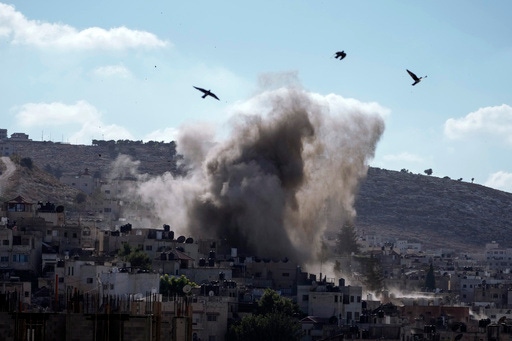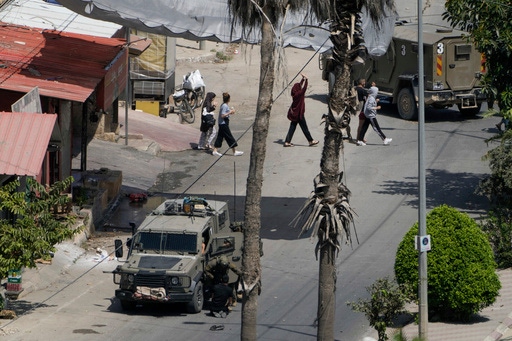Israeli forces appear to withdraw from Jenin. But the operation may not be over

An explosion is seen during an Israeli military operation in the West Bank city of Jenin, Thursday, Sept. 5, 2024. (AP Photo/Majdi Mohammed)[ASSOCIATED PRESS/Majdi Mohammed]
JENIN REFUGEE CAMP, West Bank (AP) — Israeli forces appeared to have withdrawn from three refugee camps in the occupied West Bank by Friday morning, after a more than weeklong military operation that left dozens dead and a trail of destruction.
Overnight, Israeli armored personnel carriers were seen leaving the Jenin refugee camp from a checkpoint set up on one of the main roads. An Associated Press reporter inside the camp saw no evidence of any remaining troops inside as dawn broke Friday.
After days largely trapped in their homes, residents of the Jenin camp emerged to take stock of the damage from what officials said was the most destructive assault in years. Twisted rebar protruded from the concrete of collapsed buildings. Walls still standing were pockmarked by bullets and shrapnel.
During the operation, Israeli military officials said they were targeting militants in Jenin, Tulkarem and the Al-Faraa refugee camps in an attempt to curb recent attacks against Israeli civilians. They say such attacks have become more sophisticated and deadly since Israel launched its campaign in Gaza in response to Hamas’ attack on Israel nearly 11 months ago.
Troops were pulled out of the Tulkarem camp by Friday morning and had left Al-Faraa earlier, but in a statement the Israeli military suggested that the operation wasn’t yet over.
“Israeli security forces are continuing to act in order to achieve the objectives of the counterterrorism operation,” the military said in a statement.
Hundreds of Israeli troops have been involved for more than a week in what has been their deadliest operation in the occupied West Bank since the Israel-Hamas war began, employing what the United Nations called “lethal war-like tactics.”
The main focus has been the Jenin refugee camp, a densely built district home to around 20,000 Palestinians where armed groups – including Hamas and Islamic Jihad, but also other factions advocating “resistance” to Israel’s occupation – have a powerful presence.
Fighting in Jenin accounts for 21 of 39 Palestinians who local health officials say have been killed during the Israeli push in the West Bank. The military says most have been militants.
The fighting has had a devastating effect on Palestinian civilians living in Jenin.
Water and electric services have been cut, families have been confined to their homes and ambulances evacuating the wounded have been stopped on their way to nearby hospitals, as Israeli soldiers search for militants. Israeli military bulldozers ripped up roads.
Jenin’s governor, Kamal Abu al-Rub, said that the damage to infrastructure was extensive.
“We had numerous invasions in the past, but this invasion is the most destructive,” he said. He said that ambulances came under fire during the assault, with one doctor wounded. The economy in the camp, where unemployment already ran at 21%, had been further wrecked, he said.
An Israeli military official speaking to the AP acknowledged the infrastructure destruction, but said it was because of militants’ strategy of planting explosives in civilian areas. The official spoke on condition of anonymity in line with military regulations.
Tulkarem camp saw similar damage. In the quiet morning on Friday, resident Ziad Abu Tahoun looked with dismay at the torn-up streets and crumbled buildings.
“Look at the condition of the camp, the camp is in a deplorable state,” he said. “They’ve set us back 60 years.”
In southern Gaza, health workers resumed vaccinating children against polio, continuing the second phase of a large-scale immunization campaign.
Children lined up early in the morning outside a United Nations health center in Khan Younis to receive the vaccine, which was being administered by local health care crews in coordination with UNICEF and the World Health Organization.
The first phase started Sunday in hospitals and medical locations in the central Gaza Strip. The final phase was to focus on the north, finishing Sept. 9.
The operation was undertaken as an urgent measure to prevent a large-scale polio outbreak after health officials confirmed the first reported polio case in 25 years, in a 10-month-old boy who is now paralyzed in the leg.
WHO reached an agreement with Israel for limited pauses in the fighting to allow for the vaccination campaign to take place. In all, WHO hopes to be able to vaccinate 640,000 Palestinian children in Gaza against polio.
The war in Gaza began when Hamas and other militants staged a surprise attack on Israel on Oct. 7, killing around 1,200 people, primarily civilians. Hamas is believed to still be holding more than 100 hostages. Israeli authorities estimate about a third are dead.
Israel’s retaliatory offensive has killed more than 40,000 Palestinians, according to the Health Ministry in Hamas-controlled Gaza, which doesn’t distinguish between civilians and combatants in its count. The ministry reports that more than 94,000 more have been wounded since the start of the war.
Israel has been under increasing pressure from the United States and other allies to reach a cease-fire deal in Gaza, but Prime Minister Benjamin Netanyahu insists on a demand that has emerged as a major sticking point in talks — continued Israeli control of the Philadelphi corridor, a narrow band along Gaza’s border with Egypt where Israel contends Hamas smuggles weapons into Gaza. Egypt and Hamas deny it.
Hamas has accused Israel of dragging out months of negotiations by issuing new demands, including for lasting Israeli control over both the Philadelphi corridor and a second corridor running across Gaza.
Hamas has offered to release all hostages in return for an end to the war, the complete withdrawal of Israeli forces and the release of a large number of Palestinian prisoners, including high-profile militants — broadly the terms called for under an outline for a deal put forward by U.S. President Joe Biden in July.
___
David Rising reported from Bangkok. Julia Frankel contributed to this story from Jerusalem.
Copyright 2024 The Associated Press. All rights reserved. This material may not be published, broadcast, rewritten or redistributed without permission.
